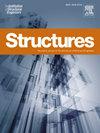Three-dimensional high fidelity mesoscale rapid modelling algorithm for concrete
IF 3.9
2区 工程技术
Q1 ENGINEERING, CIVIL
引用次数: 0
Abstract
This paper presents a novel computational algorithm to improve the three-dimensional (3D) mesoscale model of concrete, which provides several advanced features. As a key aspect, the traditional background mesh mapping method and material identification algorithms are ameliorated to make concrete model more consistent with its actual mesoscopic characteristics. Moreover, manual modelling and secondary development for modelling by ABAQUS/CAE are avoided because the finite element model is implemented by Python script, which executed multiple tasks such as randomly modelling, meshing model, extract or output model information etc. The proposed algorithm prominently reduces the time consumption in modelling compared with ordinary mesoscopic modelling process. Finally, the reliability and validity of this algorithm were rigorously demonstrated by finite element case studies of concrete specimens subjected to uniaxial compression and uniaxial tension. It is noteworthy that this algorithm is an integrated framework for modelling materials of the concrete class as an exceedingly helpful computer-aided tool.
混凝土三维高保真中尺度快速建模算法
本文提出了一种改进三维(3D)混凝土中尺度模型的新型计算算法,该算法具有多项先进功能。其中一个重要方面是改进了传统的背景网格映射方法和材料识别算法,使混凝土模型更符合其实际的中观特性。此外,由于有限元模型由 Python 脚本实现,可执行随机建模、网格模型、提取或输出模型信息等多项任务,因此避免了 ABAQUS/CAE 的手动建模和二次开发。与普通的网格建模过程相比,所提出的算法大大减少了建模所消耗的时间。最后,通过对受到单轴压缩和单轴拉伸的混凝土试件进行有限元案例研究,严格证明了该算法的可靠性和有效性。值得注意的是,该算法是混凝土类材料建模的综合框架,是一种非常有用的计算机辅助工具。
本文章由计算机程序翻译,如有差异,请以英文原文为准。
求助全文
约1分钟内获得全文
求助全文
来源期刊

Structures
Engineering-Architecture
CiteScore
5.70
自引率
17.10%
发文量
1187
期刊介绍:
Structures aims to publish internationally-leading research across the full breadth of structural engineering. Papers for Structures are particularly welcome in which high-quality research will benefit from wide readership of academics and practitioners such that not only high citation rates but also tangible industrial-related pathways to impact are achieved.
 求助内容:
求助内容: 应助结果提醒方式:
应助结果提醒方式:


